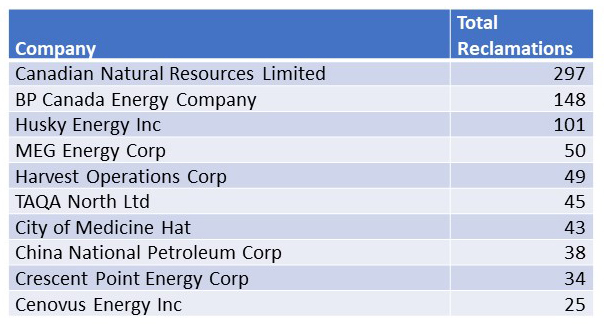Word to the Wise: Reclamations in the WCSB: looking at the past six months
September 29, 2020
Each week, XI Technologies scans its unique combination of enhanced industry data to provide trends and insights that have value for professionals doing business in the WCSB. If you’d like to receive our Wednesday Word to the Wise in your inbox, subscribe here.
A month ago, we took a look at the state of liabilities in the WCSB and how they’ve improved since January. This week, we wanted to take a deeper look at one part of that equation and examine the reclamation work being done in Western Canada (specifically Alberta, Saskatchewan, and British Columbia). Reclamation work is some of the most important liability work environmentally, as it signifies the land is ready to return to its previous state — the subsoil has been recontoured, the topsoil replaced, the vegetation re-established. It’s important to recognize that despite the challenges facing the oil and gas industry, our industry is fulfilling its environmental commitments.
To do so, we’ll examine the past six months of reclamations in Alberta, Saskatchewan, and British Columbia (data from Manitoba was not available). This data is based on the license status change for a site, which is to say that it’s not necessarily reflective on when the work was done, but when the status changed according to the regulators (i.e., when the site has officially been “reclaimed”).
Reclamations in Western Canada

Above are the total reclamations in the past six months, broken down by province. We’ve supplied values for these reclamations, both using an LLR cost model based on the regulator cost models and XI’s cost model — the latter considers many real-word factors left out of the LLR model. For a look at five major differences between XI’s proprietary third-party cost model and regulator LMR costs, download this case study. The biggest difference noted here is due to regulators understating reclamation costs, and not factoring in remediation costs.
Using XI’s cost model, you see that operators in these western Canadian provinces took an estimated $57 million off their books in the past six months, reclaiming 1246 well sites.

The chart above details which operators were most active in the past six months in terms of reclamations.
With the exception of recent regulations from BC, there haven’t been consistent site closure mandates across the WSCB jurisdictions. From a liability standpoint, inactive sites that have not been properly remediated and reclaimed are an area of concern to the public. These numbers serve as evidence that operators with means are serious about tackling reclamations to both reduce their on-paper ARO and meet Environmental, Social & Governance (ESG) responsibilities despite the lack of governmental mandate.
This data was calculated using XI’s liability software module, AssetBook ARO Manager. ARO Manager is the only standardized tool for estimating and monitoring asset retirement obligations in Western Canada’s oil and gas sector. To learn how XI’s ARO Manager can help with the planning and reporting of liability management, visit our website or contact us for a demo.